Chris delivers a premium product, in every way.
I’m an experienced wildlife photographer and I’ve had puffins on my bucket list for several years. Around my Colorado home, I scout my own sites and work my network of photography buddies, so I know what it takes to find good sites, get in and then have the wildlife cooperate, to get good pictures. I’ve even been a scout for a leading professional photographer, looking for superior deer and turkey subjects and locations.
Regarding puffins, I’d considered renting hide times, but most involved day-trips on boats. Most importantly, time in the hide is limited and you won’t necessarily be able to shoot when they’re feeding, nor will you likely shoot in the ideal light. The angle of view is often not ideal from a hide.
I don’t know how, but I ran across Chris’ Deluxe Puffins Galore Workshop at the Mingan Archipelago National Park of Canada. It sounded too good to be true. You can shoot ALL DAY and have gourmet meals morning, noon and night. Hang on.
The “galore” part of the title is entirely true. I took over 13,000-shots in my three-days. It required merciless culling to get down to under 200 for sharing. I have many worthy of framing and the culls contain many shots that I might have been happy with, had I not had so many superior shots.
There are rules, to protect the birds, about where you can go on the islet, but that in no way excludes you from puffin activity. For example, every evening, we sat in chairs as puffin filled our frames landing, taking off, kibitzing, posing, all in the ideal light. By the end of the first day, I didn’t know how I’d possibly improve my shots, but I did, indeed, add to my archive.
Importantly, Chris is an affable and professional guy, but he pays close attention to safety, respect for our subjects, and the comfort of his guests. Everyone in my group was experienced, with good equipment. In fact, I was the only newbie. All had shot with Chris before. Guess what, I’ve signed up for his Snowy Owl Adventure, next January. I suspect that won’t be my last.
Chris delivers a premium product, in every way. Planning information was thorough and detailed, making it crystal clear what you needed to get there, to wear, etc.. The only thing left was to take the pix.
This is a premium product and a photographer’s dream. This is THE way to shoot Atlantic puffin.
Dave Stephens Colorado | USA
















